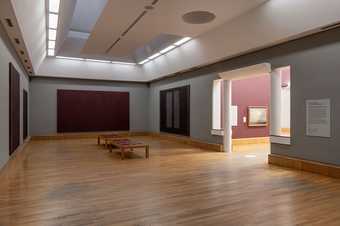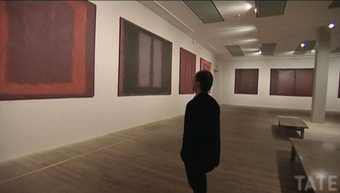SIMON GRANT Your father Mark Rothko greatly admired the art of J.M.W.Turner and famously remarked of his connection to the artist during a visit to the Turner exhibition at the Museum of Modern Art, New York, in 1966 saying: ‘This man Turner, he learnt a lot from me’. Do you know when he first saw Turner’s work?
CHRISTOPHER ROTHKO He was certainly aware ofTurner’s paintings in American collections. Before the MoMA exhibition, he may well have seen the five Turner oils in the Frick Collection, and would have probably known about the several Turners in the National Gallery of Art, Washington, which include, among others, the late work The Evening of the Deluge c.1843.
SG Do you know if he sought out Turner’s pictures on his visits to London in the 1950s and 1960s?
KATE ROTHKO PRIZEL yes, absolutely. I travelled with him and our mother on trips to Europe at that time, first in 1959 and then again in 1966. I remember visiting the Tate on both trips, and that my father studied Turner’s work intently. I think what so attracted him to Turner was his use of colour and light. Interestingly, my father’s focus on Turner’s use of light reminded me of visits to the Rembrandt rooms at the Metropolitan Museum of Art in New York, when he always pointed out to me Rembrandt’s unique ability to capture light. I believe my father connected particularly with the later, more abstract work by Turner, perhaps because the simplification of these works and, therefore, the direct communication with the emotions of the viewer, was what he was seeking to achieve in his own paintings.
SG Norman Reid, who was the director of Tate Gallery at that time, had developed a friendship with your father. In the autumn of 1965, he visited him in his New York studio. A few days later your father wrote to Reid about potentially gifting work, explaining how ‘the whole idea sprang newly born as we sat facing each other’. Do you think that his admiration of Turner, and the prospect of his work sharing the same space, may have influenced his generous proposition?
KRP I think the idea of gifting the works to the Tate was certainly initiated by my father’s feelings about the collection there, and his love of Turner. There was also the very strong personal connection that he had with the St Ives group of artists, whom he had travelled to visit on our 1959 trip. He had re-engaged with them when he made a trip to London in 1961 for his solo exhibition at the Whitechapel Art Gallery. It is worth saying that my father would not get on an aeroplane, so he made the trip to England by boat and was gone for almost three weeks for a one-week visit. So he clearly felt a close English connection in addition to his great admiration for Turner.
My feeling is that my father also developed a strong personal connection with Norman Reid. This relationship probably began with Reid’s visit to his studio in 1965, and clearly continued during our trip to London in 1966, when he made several visits to the Tate specifically to meet with him.
SG Christopher, in writing about your father’s painting it is fascinating how some of the descriptive words you use could also apply to Turner. For example, you write about the ‘tangible intangibility’ of your father’s work, which seems to echo how one might describe the experience of viewing a late Turner.
CR Absolutely, I think this is one of the reasons he was attracted to Turner. There is that sense of inner glow or light that comes from the paintings. I think he was very much trying to capture the same feeling that Turner had aimed for. But there’s also that sense of ethereality… aspects that on the one hand seem so solid and yet on the other are ungraspable. So, it seems to me that there is a similar sensibility in both of their painting.
SG The first painting by Turner to enter an American collection was Staffa, Fingal’s Cave c.1832, bought by James Lenox in 1845. When Lenox received the painting, he complained about the ‘indistinctness’ of it. Turner would write back in response: ‘Indistinctness is my fault’. Indistinctness is now regarded as one aspect that people enjoy within Turner’s late work in particular, and it may be for a similar reason that your father’s work appeals to so many.
CR Yes, and I think his work also has a sense of contradiction. On the one hand, he says: ‘I’m painting real objects that are here; I’m not interested in illusion’, and yet on the other, these large, apparently solid, rectangles seem to float in space, are somehow intangible. Again, I think that highlights the duality of our physical being and our questing spirit. Both painters captured that tension between the two poles of human existence.
KRP Yes. And there is not only an impression of intangibility on viewing these works, but also the very distinct feeling that these are not paintings about nothing.
CR Yes, my father was very clear that his paintings are not about nothing. They are not about voids. They are in fact posing questions, and have their own contents that invite a response. They are suggestions, and not concrete in terms of being final answers. They are the beginning of a journey. And when you look at a late Turner, and stare off into the mists and the fog, you get lost on the beginning of a comparable journey of discovery.
KRP I would say in conjunction with that, that I think one of the reasons that my father bristled so much at the upcoming generation of minimalist painters is that they would tell him that they were taking inspiration from his work – but in terms of their aims, they were the absolute antithesis.
CR I’d add that what I think they took from Rothko was the experiential quality of art: that art is not about showing a particular thing, but is something that has to be experienced. It is through that experience that you actually have a meaningful interaction. And that was their prime take-away – even though pictorially, I agree, their art was actually quite different.

Mark Rothko’s Red on Maroon 1959 and Black on Maroon 1958 on display as part of Rothko and Turner at Tate Britain
© 1998 Kate Rothko Prizel & Christopher Rothko ARS, NY and DACS, London. Photo © Tate (Joe Humphrys)
SG Your father would describe his paintings as ‘dramas’. What did he mean by this?
KRP It was the idea that he felt he was playing out human experience and human emotion in his paintings; that they were not static. And perhaps also that he wanted to engage the audience in the same way that an actor might want to engage an audience, or even the playwright. It is interesting that he acted as a young man, and we’ve often joked that maybe he would have expressed himself that way if he hadn’t pursued visual art. I think he felt he had a message to convey and finally determined that the visual was the best way to do it.
SG Was Turner also creating a similar emotional sensibility with his audience?
CR The earlier paintings have more narrative – or, at least they start with a narrative, but then their sense of larger life drama – the existential questions – seems to go beyond what their narrative suggests.
SG I know that your father dismissed suggestions that he was influenced by childhood memories of the Latvian landscape, and later the landscape around Portland, Oregon. Meanwhile, Turner would stuff a sketchbook into his pockets and head for the countryside at the earliest opportunity...
CR I don’t think our father left the studio very much, and he left New York reluctantly. There are exceptions to that, but if you want to talk about Rothkos as landscapes, you need to talk about them as internal and emotional landscapes. Thinking about Turner, he may have repeatedly sketched outside, but he drew a lot on the internal as well.
SG Christopher, you’ve written about your father’s near-sightedness. Turner was long-sighted, according to surviving glasses that we know about. And, like many, his eyesight deteriorated as he got older. Observers have speculated about the connections between his deteriorating eyesight and his late work. Do you think that has any parallels with your father’s work?
CR People have talked about the soft-edged, apparently out-of-focus, appearance of Rothko’s classic work being linked to his eyesight. He was quite myopic – he was, I think, actually legally blind without his glasses. I’ve inherited his eyesight. When you are that near-sighted, you just don’t go anywhere without your glasses. However, what I remark upon is that, as artists get older, their technique often gets looser. I love landscape painting and I tend to love the later works of landscape painters. They get less focused on little details and they’re just much more involved in the sweep – the skies become much more abstract. I grew up as the son of an abstractionist, so I happen to particularly take to that, but I wonder if it’s actually a function of ageing rather than eyesight.
KRP But it is interesting that he laboured so hard and broke into this hard-edged mode towards the end of his life. That was a new experimentation for him in a sense. Or even looking at some of the murals for the Rothko Chapel, for example, it is notable how much he agonised over its exact proportions. So, maybe he was working outside of his normal comfort zone for someone at that stage.
A selection of Mark Rothko's Seagram Murals are on display at Tate Britain.
Christopher Rothko is a writer and Kate Rothko Prizel is a retired physician. Together, they are co-custodians of the Rothko legacy.
Simon Grant is Editor of Tate Etc.



